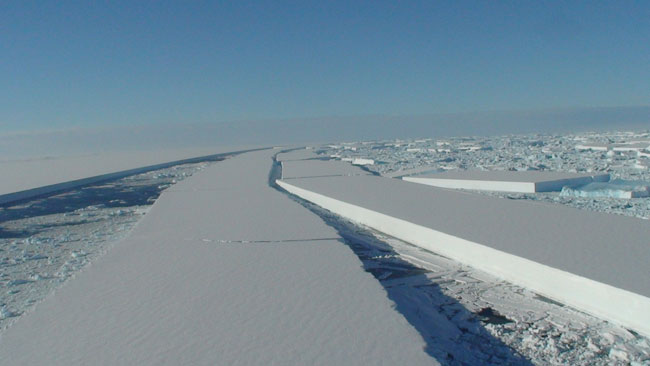Vast Antarctic Ice Shelf on Verge of Collapse

A vast ice shelf hanging on by a thin strip looks to be the next chunk to break off from the Antarctic Peninsula, the latest sign of global warming’s impact on Earth's southernmost continent. Scientists are shocked by the rapid change of events. Glaciologist Ted Scambos of the University of Colorado was monitoring satellite images of the Wilkins Ice Shelf and spotted a huge iceberg measuring 25 miles by 1.5 miles (41 kilometers by 2.5 kilometers) that appeared to have broken away from the shelf. Scambos alerted colleagues at the British Antarctic Survey (BAS) that it looked like the entire ice shelf — about 6,180 square miles (16,000 square kilometers — about the size of Northern Ireland)— was at risk of collapsing. David Vaughan of the BAS had predicted in 1993 that the northern part of the Wilkins Ice Shelf was likely to be lost within 30 years if warming on the Peninsula continued at the same rate. "Wilkins is the largest ice shelf on the Antarctic Peninsula yet to be threatened," he said. "I didn't expect to see things happen this quickly. The ice shelf is hanging by a thread — we'll know in the next few days and weeks what its fate will be." Aircraft reconnaissance The BAS scientists sent an aircraft out on a reconnaissance mission to survey the extent of damage to the ice shelf. Jim Elliot, who captured video of the breakout said, "I've never seen anything like this before — it was awesome. We flew along the main crack and observed the sheer scale of movement from the breakage. Big hefty chunks of ice, the size of small houses, look as though they've been thrown around like rubble — it's like an explosion." An initial iceberg calved away from the Wilkins Ice Shelf on Feb. 28. A series of images shows the edge of the ice shelf proceeding to crumble and disintegrate in a pattern characteristic of climate-caused ice shelf retreats throughout the northern Antarctic Peninsula. The disintegration left a sky-blue patch of hundreds of large blocks of exposed old glacier ice floating across the ocean surface.
Though these broken chunks of ice have spread into the sea, they won't raise sea levels because the ice shelf was already floating on the water.
By March 8, the ice shelf had lost just over 160 square miles (414 square kilometers) of ice, and the disintegrated ice had spread over 540 square miles (1,400 square kilometers). As of mid-March only a narrow strip of shelf ice between Charcot and Latady islands was protecting several thousand more kilometers of the ice shelf from potentially breaking up. The region where the Wilkins Ice Shelf lies has experienced unprecedented warming in the past 50 years, with several ice shelves retreating in the past 30 years. Six of these ice shelves have collapsed completely: Prince Gustav Channel, Larsen Inlet, Larsen A, Larsen B, Wordie, Muller and the Jones Ice Shelf. Antarctic warming The Wilkins Ice Shelf was stable for most of the last century until it began retreating in the 1990s. A previous major breakout occurred there in 1998 when 390 square miles (1,000 square kilometers) of ice was lost in just a few months. "We believe the Wilkins has been in place for at least a few hundred years, but warm air and exposure to ocean waves are causing it to break up," Scambos said. The Antarctic Peninsula has warmed faster than anywhere else in the Southern Hemisphere; temperature records show that the region has warmed by nearly 3 degrees Celsius during the past 50 years — several times the global average and only matched in Alaska. Other parts of Antarctica, including the East Antarctic Ice Sheet, seem to be more stable, though areas of melt have been observed in recent years. Melting in the Antarctic is different than the recent record melt in the Arctic. Antarctica is composed of ice sheets, or huge masses of ice up to 2.5 miles (4 kilometers) thick that lie on top of bedrock and flow toward the coast, and ice shelves, the floating extensions of ice sheets. Arctic ice is primarily sea ice, some of which persists year-round and some of which melts in the summer and freezes again in the winter.
- Video: Antarctic Ice Shelf Disintegration
- North vs. South Poles: 10 Wild Differences
- Images: Ice of the Antarctic
Sign up for the Live Science daily newsletter now
Get the world’s most fascinating discoveries delivered straight to your inbox.

Andrea Thompson is an associate editor at Scientific American, where she covers sustainability, energy and the environment. Prior to that, she was a senior writer covering climate science at Climate Central and a reporter and editor at Live Science, where she primarily covered Earth science and the environment. She holds a graduate degree in science health and environmental reporting from New York University, as well as a bachelor of science and and masters of science in atmospheric chemistry from the Georgia Institute of Technology.









